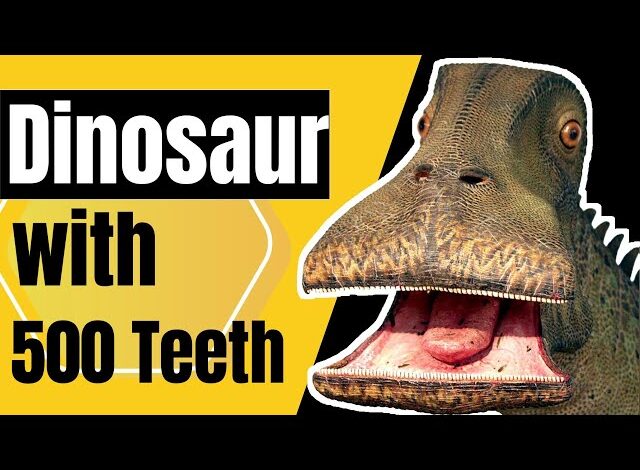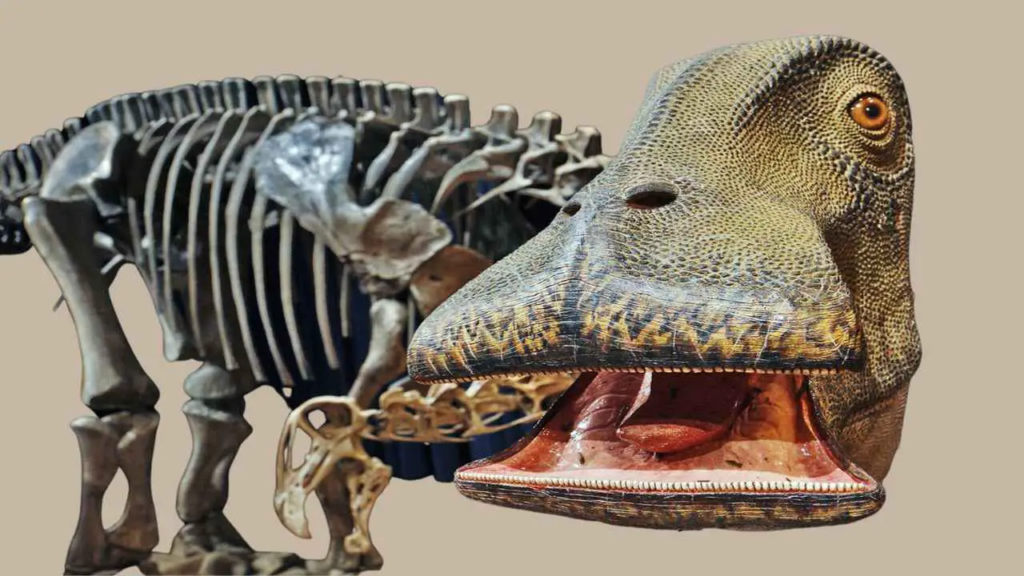Title: Exploring What Dinosaur Has 500 Teeth: Unveiling the Mystery

What Dinosaur Has 500 Teeth?
Dinosaurs, those ancient giants that roamed the Earth millions of years ago, continue to fascinate palaeontologists and enthusiasts alike. Among the many remarkable traits of these prehistoric creatures, one that stands out in particular is their teeth. Some dinosaurs had sets of teeth that were more specialized than others, each serving different purposes—tearing through flesh to grinding plant matter. But when it comes to the question of “what dinosaur has 500 teeth?” there’s one standout answer: the Nigersaurus.
The Nigersaurus, a plant-eating dinosaur that lived during the Cretaceous period, is known for its unique dental features. With a jaw entire of up to what dinosaur has 500 teeth, this dinosaur provides a remarkable example of evolutionary adaptation. But why did Nigersaurus have so many teeth, and what did they look like? Let’s look closer at this fascinating dinosaur and uncover the details behind its toothy mystery.
The Nigersaurus: The Dinosaur with an Extraordinary Set of Teeth
The Nigersaurus was a relatively small, plant-eating dinosaur that lived around 115 million years ago during the Cretaceous period. This dinosaur is best known for its vast number of teeth, which are estimated to number around 500 in total. The Nigersaurus lived in what is now the Sahara Desert, an area that was once lush and covered in vegetation. Its teeth were adapted to help it feed on the dense, low-lying plants that dominated its environment.
what dinosaur has 500 teeth What’s truly unique about the Nigersaurus’s teeth is their sheer number and arrangement. Unlike most herbivorous dinosaurs with relatively broad teeth for grinding and chewing rigid plant material, the Nigersaurus had rows of smaller, needle-like teeth perfect for snipping off plant matter. Its teeth were arranged in a way that allowed it to continuously replace old teeth throughout its life, ensuring it always had a fresh set to munch on vegetation.
This dental arrangement suggests that the Nigersaurus had a what dinosaur has 500 teeth specialized feeding strategy, likely feeding on low shrubs and delicate plants instead of the more complex, thicker plants consumed by other herbivorous dinosaurs. The extensive number of teeth helped it remain efficient in feeding habits, as it could constantly replace its teeth without missing a beat.
How Did the Nigersaurus’s Teeth Function?
The teeth of the Nigersaurus were not just numerous—they were highly functional. These teeth played a crucial role in the dinosaur’s ability to process food efficiently. The teeth were arranged in a unique “dental battery.” This arrangement allowed the Nigersaurus to have a continuous supply of fresh teeth, which helped it constantly replace the worn-out ones throughout its life.
Each tooth in the Nigersaurus’s mouth was relatively small but highly sharp, like the what dinosaur has 500 teeth of modern-day reptiles that feed on plant material. These teeth were optimized for snipping off plant matter rather than grinding it. This allowed the Nigersaurus to feed in a manner that was both efficient and effective, allowing it to thrive in its particular ecological niche.
Interestingly, the dental battery arrangement of the Nigersaurus is very similar to that of some modern-day herbivores, such as iguanas. The replacement of teeth in the Nigersaurus was likely a critical adaptation that helped it continue to thrive despite the challenges posed by its environment.
Why Did the Nigersaurus Evolve to Have So Many Teeth?

At first glance, having what dinosaur has 500 teeth might seem excessive, but for the Nigersaurus, this adaptation was essential to its survival. Evolution works through natural selection, where traits that provide a survival advantage become more common in a population over time. In the case of the Nigersaurus, having so many teeth helped it stay competitive in a world filled with other herbivores.
The Nigersaurus likely lived in an environment where food resources were abundant, but competition for them was fierce. An extensive array of teeth would have allowed it to efficiently snip off plant material and process large quantities of food. This efficiency in feeding would have been vital for survival, as it enabled the Nigersaurus to meet its nutritional needs while avoiding the more cumbersome task of grinding and chewing tough plants.
Additionally, the fact that the Nigersaurus had such a high turnover rate of teeth would have ensured that it could continue to feed efficiently throughout its life, even as its teeth wore down. In environments where food might be challenging to come by, or competition might be high, having a constant supply of fresh teeth would have been a significant advantage for this dinosaur.
The Anatomy of the Nigersaurus: More Than Just Teeth
While the Nigersaurus’s teeth are certainly one of its most fascinating features, its overall anatomy is just as intriguing. The Nigersaurus was a relatively small dinosaur, measuring just about 30 feet in length. It had a long neck and a relatively small head, which helped it graze on low-lying vegetation.
One of the most notable aspects of the Nigersaurus’s anatomy was its flat, broad face. This feature was ideal for browsing plants near the ground, as it allowed the dinosaur to sweep through the underbrush and snip off plant material quickly. The shape of its face also suggests that it likely had a specialized feeding behaviour, focused on consuming small, soft plants rather than significant, thorny vegetation.
Its long neck, combined with the unique shape of its skull, would have given it a distinct advantage in terms of feeding. By keeping its body low to the ground and moving through dense vegetation, the Nigersaurus could have grazed without the need to stand on its hind legs or reach for food higher up in trees or shrubs.
The Nigersaurus and Its Environment: A Look at the Cretaceous Period
To fully understand the role of the Nigersaurus and its dental adaptations, it’s essential to consider the environment in which it lived. The Nigersaurus lived during the Cretaceous period, around 115 million years ago. At that time, the world differed from what we know today. The Sahara Desert, where the Nigersaurus was discovered, was once a lush, green region filled with abundant plant life and various species of dinosaurs.
what dinosaur has 500 teeth During the Cretaceous period, the Earth’s climate was much warmer, allowing dense forests and vegetation to thrive in many areas. The Nigersaurus would have lived in an environment rich with plant life, much of it low-lying and soft, consistent with the types of plants the dinosaur is believed to have fed on.
With this environment, the Nigersaurus would have had to compete with other herbivorous dinosaurs for food. Its specialized feeding strategy—evidenced by its 500 teeth—would have allowed it to access this abundant food supply efficiently.
The Discovery of the Nigersaurus and Its Teeth
what dinosaur has 500 teeth The Nigersaurus was first discovered in the 1990s by palaeontologist Philippe Taquet in the Niger region of Africa. The discovery of this dinosaur was significant not only because of its unique dental features but also because it shed new light on the diversity of herbivorous dinosaurs that once roamed the Earth.
Upon its discovery, scientists were astonished by the large number of what dinosaur has 500 teeth in the Nigersaurus’s jaw. Detailed analysis of the fossilized remains revealed that this dinosaur had a highly specialized set of teeth, perfect for a life of continuous grazing on low-lying plants. The fossilized skull of the Nigersaurus also showed evidence of the dental battery, with rows of teeth that would have been constantly replaced as they wore down.
The Nigersaurus was also one of the first dinosaurs found to have a specialized feeding behaviour similar to that of some modern reptiles. This discovery helped to broaden our understanding of the variety of feeding strategies that dinosaurs employed and how they evolved to survive in their respective environments.
Conclusion: The Remarkable Legacy of the Nigersaurus
In conclusion,what dinosaur has 500 teeth, the Nigersaurus, is one of the most fascinating creatures to have ever lived. Its specialized dental features and efficient feeding strategies provide an exceptional example of evolutionary adaptation. Its discovery has expanded our knowledge of prehistoric life and helped palaeontologists understand how dinosaurs evolved to meet the challenges of their environment.
While the Nigersaurus may not have been the largest or most fearsome dinosaur to roam the Earth, its unique dental adaptations set it apart as a remarkable example of evolution at work. The Nigersaurus’s teeth tell a story of survival, specialization, and the continuous push for organisms to adapt to their surroundings—a story that continues to captivate scientists and enthusiasts alike.






